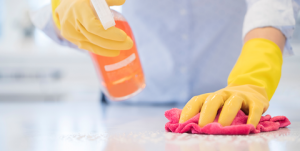
Within a relatively short space of time, the coronavirus has radically changed working life around the world, perhaps forever in the case of some organisations. Never before has workplace cleaning taken on life and death implications across so many different types of work settings.
There have always been workplaces when good hygiene is, quite simply, a matter of life and death. Nurses and doctors understand full well the importance of scrupulously clean, disinfected operating theatres. Likewise, food safety experts have long emphasised the importance of caterers and other food industry workers being sure to diligently cleanse fresh produce and sanitise kitchen working surfaces and other equipment.
It should be noted that deep cleaning isn’t really a scientific term as such. The latest UK Government advice published in March 2020 by Public Health England (PHE) refers simply to the “cleaning” of workplaces and working areas which may have been contaminated by the COVID-19 virus. The new guidance, specifically written in the context of COVID-19, has been published using the health authorities’ experiences of other viruses within the corona family, such as SARS and MERS, and will no doubt be updated as more is discovered about the virus.
It may, firstly, be useful to distinguish between cleaning and disinfecting:-
Cleaning refers to the removal of germs, dirt and impurities from surfaces. It does not kill germs, but by removing them, it lowers their numbers and the risk of spreading infection.
Disinfecting refers to using chemicals, for example suitable disinfectants, to kill germs on surfaces. This process does not necessarily clean dirty surfaces or remove germs, but by killing germs on a surface after cleaning, it can further lower the risk of spreading infection.
Any kind of workplace might need deep cleaning if there has been the risk of contact with someone with COVID-19 and, of course, there are specialist guidelines for healthcare settings such as hospital wards and operating theatres. The new advice from PHE however focuses on non-healthcare environments which could include settings such as:
The amount of virus living on surfaces will reduce significantly after 72 hours. If a workplace area can be kept closed and secure, wait until this time has passed before cleaning.
Wherever possible, wear disposable or washing-up gloves and aprons for cleaning. This is the minimum personal protective equipment (PPE) to be worn for cleaning a workplace area where a person with possible or confirmed COVID-19 has been. These should then be double-bagged, stored securely for 72 hours and then thrown away in the regular rubbish after cleaning is finished.
Avoid creating splashes and spray when cleaning. Wash hands regularly with soap and water for 20 seconds. After all PPE has been removed, wash hands with soap and water for 20 seconds.
Remember: wiping down an area with normal household disinfectant after someone with suspected COVID-19 has left will reduce the risk of passing the infection on to other people.
PHE recommends using disposable cloths or paper roll to wipe down all hard surfaces, chairs, door handles and sanitary fittings, and using disposable mop heads for the floors.
It is important to follow the manufacturer’s instructions for dilution, application and contact times for all detergents and disinfectants.
Public areas where a symptomatic individual has passed through and spent minimal time, such as corridors, and which are not visibly contaminated with body fluids can simply be cleaned thoroughly as normal. Any cloths and mop heads used should be disposed of and put into waste bags as outlined below.
PHE suggests using steam cleaning when items cannot be cleaned using detergents or laundered, for example in the case of upholstered furniture and mattresses.
The PHE suggests washing items in accordance with the manufacturer’s instructions but using the warmest water setting and drying items completely. Dirty laundry that has been in contact with an unwell person can be washed with other people’s items, according to the guidance.
However, cleaners should be trained not to shake out dirty laundry, in order to minimise the possibility of dispersing virus through the air.
Anything used for transporting laundry with the company’s usual products, should be cleaned and disinfected in line with the latest PHE cleaning guidance.
Waste, including disposable cloths and tissues, should be put in a plastic rubbish bag and tied when full. Waste should be stored safely and kept away from children. Waste should not be put in communal waste areas but disposed of immediately.
At a time when millions of British employees are working from home, with homes having become the new global workplace practically overnight, the above principles can usefully be applied to home offices too.
However, the COVID-19 situation is fast-changing and unprecedented. Scientists’ work with COVID-19 is, at the time of writing, ongoing and so it is important to check Government guidance regularly for any changes and keep up to date with expert advice on the subject.
Contact us if you require further information.
Keep safe!!!